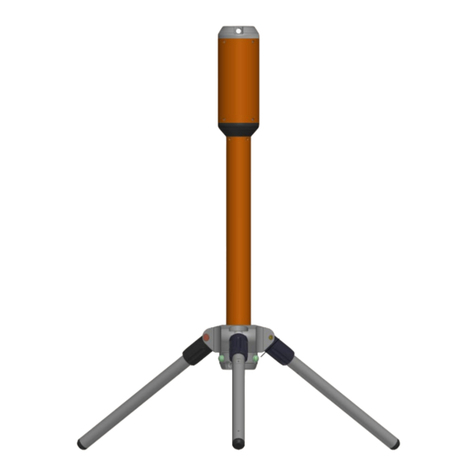
Marine Magnetics Argos hand-held diver gradiometer Operating manual
5
Initial self-tuning on power-up
The device is designed to operate under water. It will not work correctly out of the water because the water provides an electrical ground
that is important for normal operation. If you power it up (by plugging in the audio cable) while on your vessel right before you dive
(which is the typical expected power-up situation), the LED will turn solid red to indicate that there is no seawater connection, and it will
wait until a grounding connection is established.
As soon as the device is immersed in water, the status LED will flash green once, and then start flashing white to indicate that it's
operating normally.
When there is no target present, it will be pinging at 1Hz, and the rate of pinging will increase to 5 Hz as the magnetic gradient increases
(in proximity of a ferrous target).
Occasionally Argos may start working too early, before it is immersed in water, or may tune to the wrong magnetic field value (e.g. while
onboard a vessel or in proximity of a large ferrous object). Incorrect tuning may be indicated by the immediate switch to the high ping
rate following power-up. This may seem like it is detecting a magnetic target. This condition can be remedied by powering it down and
powering it up again (by disconnecting and then reconnecting the audio cable), or by manually setting the tuning to the ambient
magnetic field value (refer to following section for details).
For best results when deploying from a large vessel or in proximity of large ferrous objects, you can repower it in water after swimming
away from the source of magnetic influence (e.g. the vessel) to ensure that the initial tuning will successfully find the correct ambient
magnetic field value. Repowering can be done while holding Argos above water, or even while immersed; the connector is wet-mate-
able. If repowering while immersed, it may be necessary to place your thumb over the Argos connector after unplugging the audio cable
until you see all the LEDs go off, before re-connecting the audio cable.
LED bar
The LED bar may occasionally max-out following rapid or abrupt motion of the device in the water even when there is no magnetic object
present. This happens more with rapid rotations or swivels of the device around an axis, and may take a couple of seconds to subside.
This is normal, and a result of the complex physics governing the operation of this device. For best results, attempt to use smooth motion
while operating the device, and avoid waving it back and forth over the sea floor, shaking it, or any rapid movements. You can keep it
horizontal, or keep it at any angle, even straight down, so long as your movements are smooth and gradual.
Proximity to magnetic sources
This device is designed to detect targets as far away as possible, and the larger the target’s ferrous mass, the greater its magnetic
influence extends, and the further away it can be detected.
The device will also work fine very close to a target, even touching it. Don't be afraid to get close, or even touch the ground, or bury it
right into sand if you are trying to pinpoint the exact location of a target. When you are that close, the earpiece provides the most
valuable feedback. Much detail can be heard in the quality of the ping sound, especially at close distance to a ferrous object, once you
have accustomed your ear to the sound.
Caring for the device
Use only the charger provided with the device for charging the internal battery.
After each use, especially in salt water, we recommend rinsing the device with fresh water, same as with any diving gear.
Be sure to rinse away any stray mud or other particles after the dive. Common sand may contain a large percentage of magnetic particles,
and it is best to prevent those from accumulating in any crevices in the device.
Protect the device from direct and prolonged UV exposure, and avoid leaving it in direct sun in hot locations where it can overheat.
Always place the device in the shade when it is charging.
Never allow the device to come into contact with very strong magnets, such as neodymium magnets. Such magnets are orders of
magnitude stronger than anything found in natural ferrous structures.
Always check the state of the pressure relief valve prior to and after each use, as it may indicate an internal issue.





























